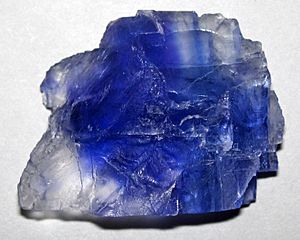Elk Point Group facts for kids
Quick facts for kids Elk Point GroupStratigraphic range: Early to Middle Devonian |
|
|---|---|

Blue halite (Prairie Evaporite Formation, upper Elk Point Group, Middle Devonian) from Saskatchewan
|
|
| Type | Geological formation |
| Sub-units | Upper and Lower Elk Point Group |
| Underlies | Beaverhill Lake Group, Manitoba Group |
| Overlies | Precambrian to Silurian formations |
| Thickness | up to 610 metres (2,000 ft) |
| Lithology | |
| Primary | dolomite, halite, anhydrite |
| Other | Limestone, shale, potash |
| Location | |
| Coordinates | 53°54′19″N 110°37′49″W / 53.9053°N 110.6304°W |
| Region | Northern plains |
| Country | |
| Type section | |
| Named for | Elk Point |
| Named by | J.R. McGehee |
The Elk Point Group is a huge set of rock layers found deep underground in parts of Canada and the United States. These rocks formed a very long time ago, during the Devonian Period, which was about 400 to 385 million years ago.
You can find the Elk Point Group stretching from the Northwest Territories in Canada all the way down to North Dakota in the United States. These rock layers are important because they hold large amounts of petroleum (oil) and natural gas.
Contents
What is the Elk Point Group Made Of?
The rocks in the Elk Point Group are mostly made of two main types:
- Carbonate rocks: These include dolomite and limestone. They are often formed from the shells and skeletons of ancient sea creatures.
- Evaporite rocks: These are rocks like halite (which is rock salt), anhydrite, and potash. They form when salty water evaporates, leaving minerals behind.
You can also find smaller amounts of mudstone and shale in these layers.
Ancient Life: Fossils in the Elk Point Group
Some of the carbonate rocks in the Elk Point Group are full of amazing fossils! These fossils are from marine (ocean) animals that lived millions of years ago.
Scientists have found many types of ancient sea creatures, including:
- Brachiopods: These look a bit like clams.
- Gastropods: These are ancient snails.
- Bivalves: Like modern clams and oysters.
- Cephalopods: Relatives of modern squids and octopuses.
- Crinoids: Sometimes called "sea lilies."
- Ostracods: Tiny crustaceans.
- Corals: Like the corals you see in reefs today.
However, the evaporite rocks, which formed from evaporating water, usually don't have many fossils. They might only contain tiny spores or remains of algae.
How the Elk Point Group Formed
The rocks of the Elk Point Group were laid down in a large, ancient ocean bay. This bay was huge, about half the size of today's Mediterranean Sea! It stretched from what is now the Northwest Territories down to North Dakota.
The environment changed a lot over time:
- Low water levels: When the water was shallow and evaporated a lot, minerals like salt (halite) were left behind. This happened in areas like salt flats (sabkhas), tidal flats, and coastal lagoons.
- High water levels: When the water was deeper, large carbonate platforms and reefs grew. These were bustling underwater communities filled with marine life.
Where is the Elk Point Group Found?
The Elk Point Group covers a very large area. It stretches across several Canadian provinces and U.S. states:
- In Canada: Southern Northwest Territories, northwestern British Columbia, Alberta, Saskatchewan, and southwestern Manitoba.
- In the United States: Eastern Montana and North Dakota.
At its thickest point, in eastern Alberta, these rock layers are about 610 meters (2,000 feet) deep!
Naming and Layers of the Elk Point Group
The Elk Point Group was named after the town of Elk Point, Alberta, in 1949 by a scientist named J.R. McGehee. Scientists study rock samples taken from deep wells to understand these layers.
The entire Elk Point Group is divided into two main parts:
- Lower Elk Point Group: This part is found only in the deepest areas of the ancient basin.
- Upper Elk Point Group: This part is found throughout the entire basin.
Each of these main parts is then divided into many smaller rock layers, called "formations." These formations are named based on the types of rocks found in them. For example, some formations are mostly salt, while others are mostly limestone or dolomite.
Relationship to Other Rock Layers
The Elk Point Group sits between other major rock units.
- Above: On top of the Elk Point Group, you'll find the Manitoba Group (in Manitoba and Saskatchewan) or the Beaverhill Lake Group (in Alberta). These layers formed after the Elk Point Group.
- Below: The Elk Point Group rests on much older rocks. In some places, it sits directly on top of ancient Precambrian rocks (the oldest rocks on Earth!). In other areas, it rests on rocks from the Cambrian, Ordovician, or Silurian periods.
Oil and Natural Gas in the Elk Point Group
The Elk Point Group is very important because its porous (meaning it has tiny holes) carbonate rocks hold large amounts of petroleum (oil) and natural gas. These rocks act like sponges, trapping the oil and gas within them.
As of 1994, scientists estimated that the Elk Point Group contained billions of cubic meters of oil and natural gas that could be recovered. This makes the Elk Point Group a key source of energy for Canada and the United States.

